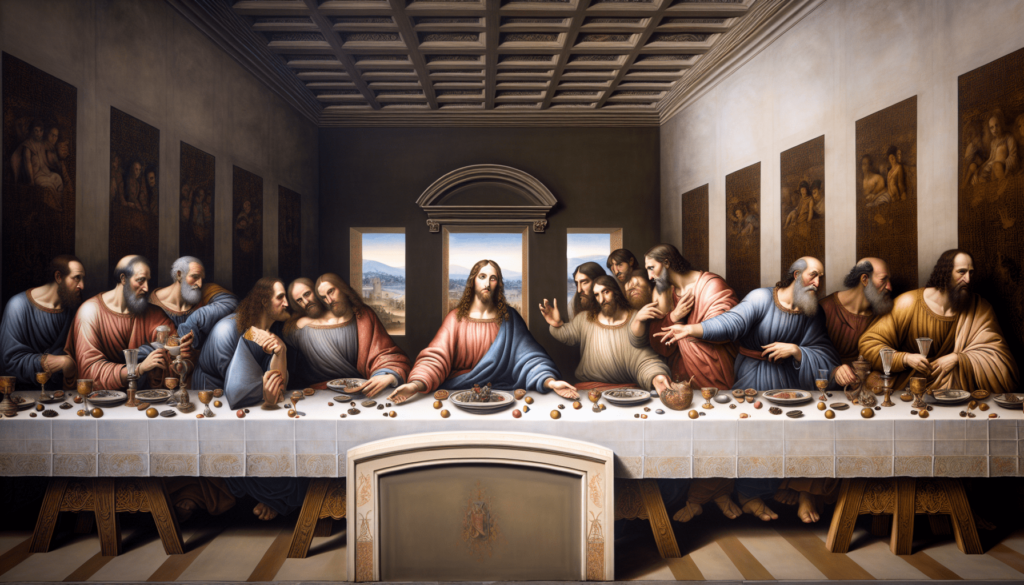
Leonardo da Vinci’s Last Supper is a Renaissance masterpiece that has struggled to survive intact over the centuries. It was commissioned by Duke Ludovico Sforza for the refectory of the monastery of Santa Maria delle Grazie in Milan, and da Vinci used an oil& tempera mix as the painting medium and applied it onto a dry wall in order to capture the look of an oil painting. However, it began to wear off even before his death. Further destruction was caused when a door was cut into the bottom of the wall in the seventeenth century which shows that da Vinci’s work was not esteemed at that time as it is today.
Da Vinci painted the room in the Last Supper in such a way that it seems like an extension to the refectory. This is quite relevant since the Last Supper takes up the basic theme (eating) from the function of the refectory. This extension of space is similar to what we see in Masaccio’s Holy Trinity fresco, painted in the church of Santa Maria Novella in Florence. This shows that da Vinci used some of the same pictorial devices that had been used by his painter-predecessors earlier in the century.
The scene shows us figures in a rectangular room with coffers on the ceiling and tapestries on both sides. There are three windows on the wall behind the table, and through these windows, we can see a beautiful landscape which terminates into a kind of misty and grayish horizon. This painting technique, in which the colors get more dull and colorless towards the horizon, is called aerial perspective and was developed by the Renaissance artists to create the illusion of depth in landscape scenes.
As far as the composition is concerned, Christ is in the center of the apostles, and his body forms a triangular shape which is not overlapped by any apostles. There are four sets of three apostles at the table beside Christ, and these numbers probably have symbolic importance for da Vinci (for example, there are four Gospels in the Bible, and three is related to the Holy Trinity). We can easily see da Vinci’s use of one-point linear perspective in which the vanishing point is at Christ’s head framed by the back-lit pediment above and the open window behind (the orthogonals can be seen by following the top edges of the tapestries or the coffers to where they intersect at Christ). Thus, it can be seen that da Vinci kept up with the innovative artistic techniques developed early in the Quattrocento.
In addition to the composition, Christ is also the center of psychological athmosphere in the painting. The scene where Christ and the apostles are together in a room for supper comes from the Gospel accounts on the night before Christ’s Passion and Crucifixion. In other words, we observe them at a point in the narrative after Christ has made a great revelation to the apostles: one of them will betray Christ (“One of you is about to betray me”, Matthew 26:21 ). He, of course, refers to Judas, but at this point, there is a commotion as all the apostles question who the betrayer is. Although the Last Supper had been conventionally depicted several times before, this particular painting is unique in its depiction of this dramatic moment of revelation which opened a door for Leonardo da Vinci to explore the psychological reactions of the figures involved. We can observe this in the apostles who are linked by their hand movements. Emotions range from protest (Philip, #8) to sadness (John, next to Christ) and to acceptance (Christ). Judas, however, is shadowed so that we can only see a part of his face while he grasps a bag containing silver pieces. Judas was conventionally seated across the table, separately from the other apostles in the Last Supper depictions, but he is depicted in the same group as John and Peter in this painting. These three figures would play prominent roles in the Passion of Christ (Judas in the betrayal, Peter with his denials, and John who remains with Christ at the cross).
Da Vinci’s the Last Supper is a kind of painting which builds upon the early Renaissance painting traditions in areas such as composition and perspective. Yet, it is innovative in terms of its study of emotional reactions and psychological states which was captured in a kind of naturalism which was unknown in Italian painting in previous centuries. Therefore, we see the the beginning of the High Renaissance with Leonardo da Vinci. It was the climactic period of the Renaissance when virtuosity was at its peak, original ways of depicting figures or scenes came full force, and the course of European art began to change as we know it today.
Visiting Last Supper
To see Leonardo Da Vinci’s Last Supper today, you must book a Last Supper Tour. The visit time of those who visit this masterpiece is very short and averages about 15 minutes.